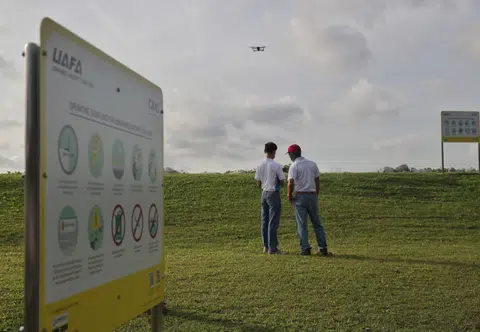Drone enthusiasts mixed about benefits of more community drone-flying areas in S'pore
Authorities are looking to add more of such community spaces around the island.
Drone-flying enthusiasts can look forward to more dedicated areas to fly their aircraft, as the authorities are looking to add up to two more of such community spaces around the island.
These are in addition to the two dedicated areas that are currently available for drones and other unmanned aircraft to be flown recreationally - one over the waters of Pandan Reservoir and another at an open field in Dover Road.
The Civil Aviation Authority of Singapore (CAAS) told The Straits Times on Sept 4 that it is working with other government agencies to identify possible new locations, including over-land and over-water options.
The move follows requests for better accessibility to such flying areas, given that the two existing ones are both located in the west, CAAS said.
"Learning from the success of existing sites, we will consider similarly accessible sites with amenities like benches," said Mr Tan Kah Han, senior director at CAAS' unmanned systems group.
"Preferably, these sites should be located some distance away from residences to minimise noise and privacy concerns. We will engage residents in the neighbourhood before we finalise any new (flying areas)," he added in response to queries from ST.
On Aug 22, CAAS called a tender for services to maintain the 16ha flying area in Pandan Reservoir, which was set up in 2022; as well as the 0.6ha flying area in Dover across the road from Singapore Polytechnic that was launched in 2024.
This includes regular touch-ups and repairs of amenities installed at the two locations, such as workbenches that provide space for users to assemble their aircraft, arches to mark the entrance of the flying area, as well as feather flags to demarcate the perimeter.
In the same Aug 22 tender, services were also sought to establish up to two new flying areas, each about 1ha in size, which is the equivalent of about 1½ football fields.
In tender documents seen by ST, CAAS said it aims to set up one new flying area over land, with the option of setting up a second area over water.
According to CAAS, the existing flying areas in Pandan Reservoir and Dover Road are used every day and more so on the weekends.
Since 2022, the authority has conducted 25 educational workshops on unmanned aircraft at the two locations, with participants ranging from students and hobby groups to nearby residents.

CAAS said there has been a steady increase in the number of registered unmanned aircraft - from 24,176 as at April 2024 to 26,540 as at March 2025 - a sign of their continued popularity.
Any unmanned aircraft with a total weight above 250g must be registered with CAAS before it can be flown here. Apart from drones, other examples of unmanned aircraft include radio-controlled aircraft and remote-controlled kites.
While CAAS said it has received positive feedback about the dedicated flying areas so far, hobbyists interviewed by ST had mixed views.
Mr Farhan Tahir, administrator of the Universal Drones Singapore Facebook hobby group, said some of the group's 8,300 members see little benefit in going to these dedicated areas.
This is because they can more easily fly their drones elsewhere, as long as they stick to the rules and avoid places where the use of unmanned aircraft is prohibited. Examples of such no-fly zones include areas within 5km of an airport or airbase, areas near protected sites like military camps, as well as other restricted zones.
Mr Farhan said members of his hobby group have also said that they are not keen to use the flying areas in Pandan Reservoir and Dover Road as there are no shelters there, so they are exposed to the sun and rain.
Other bugbears include the lack of power sources at both locations for users to charge their drone batteries, and the lack of convenient parking spots near the Dover site.
Long-time drone enthusiast Rick Tan, 54, who has flown at the Pandan Reservoir and Dover Road locations, said he prefers to go to places like Tanjong Rhu, Margaret Drive and East Coast Park, which he feels are more accessible.
He said he hopes that CAAS will make any new drone-flying areas more attractive to hobbyists, and suggested the authority work with enthusiasts to design obstacles or other structures so that pilots can test their skills and practise more challenging manoeuvres at the sites.
"There must be something special to draw us in," added Mr Tan.
On the other hand, Ms Joyce Wong, founder of aerospace education provider Just Fly It, said the designated flying areas are good places for beginners.
"Because it is a designated area, it is safer for them to fly there. As the community comes together in these places, they will also help to look out for each other," she added.
Ms Wong agreed that having convenient access to public transport and amenities like washrooms are things that CAAS should look out for when setting up new flying areas.
She added: "If CAAS can find some pockets between no-fly zones that can be developed into designated flying areas, that will be a good thing for us... The more flying areas we have, the more it encourages our community to grow responsibly."
Kok Yufeng for The Straits Times